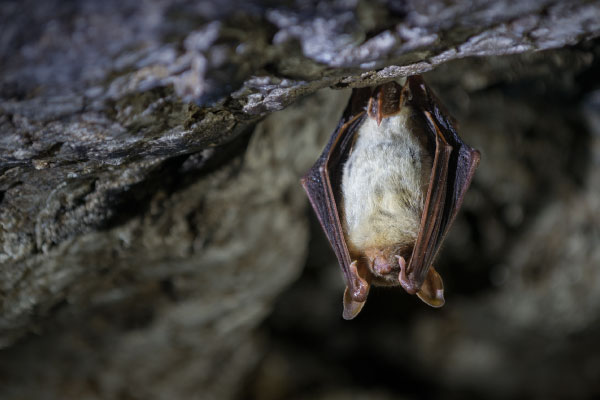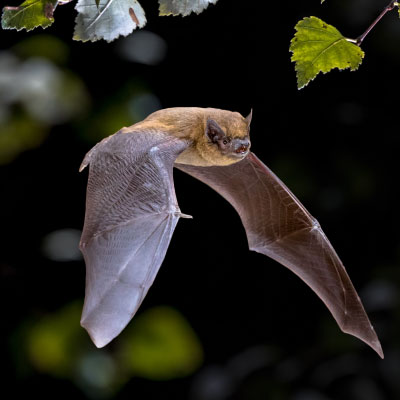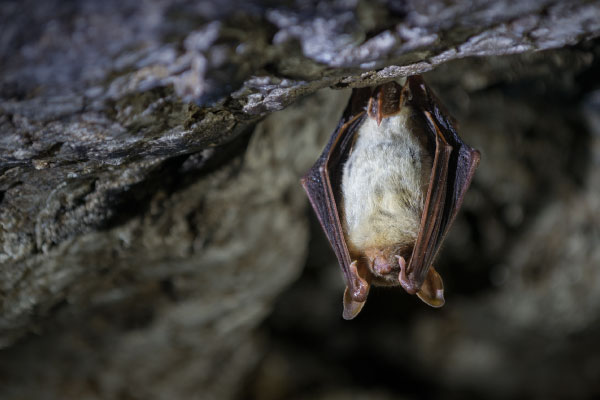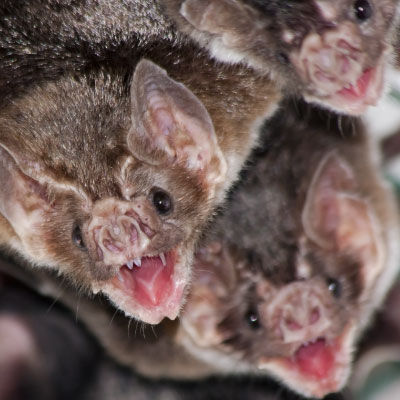El camping de invierno: sobrevive al frío con humor y aventura
El invierno es una época del año en la que muchos prefieren quedarse en casa con una taza de té...

 Durante siglos, los murciélagos han estado envueltos en mitos que no siempre han mostrado a nuestros amigos nocturnos de la mejor manera. Durante Halloween, los murciélagos se utilizan como decoración para casas encantadas y exhibiciones espeluznantes del vecindario. Las brujas verrugosas y sin dientes en palos de escoba a menudo se muestran con una horda de murciélagos dando vueltas a su alrededor y uno no puede olvidar el temor de que los murciélagos son vampiros diabólicos que solo esperan chupar la sangre de su próxima víctima. Hasta el día de hoy, algunas personas todavía se estremecen ante la visión de murciélagos dando vueltas en la cabeza esperando enredarse en el cabello humano e incluso contagiarles rabia. ¡La gente incluso cree que los murciélagos son ciegos! Es decepcionante que una criatura tan interesante esté rodeada de tantos miedos y supersticiones irracionales. No temas, querido lector, hoy estoy aquí para desacreditar algunos de los mitos más populares que rodean a nuestro fascinante amigo: el murciélago.
Durante siglos, los murciélagos han estado envueltos en mitos que no siempre han mostrado a nuestros amigos nocturnos de la mejor manera. Durante Halloween, los murciélagos se utilizan como decoración para casas encantadas y exhibiciones espeluznantes del vecindario. Las brujas verrugosas y sin dientes en palos de escoba a menudo se muestran con una horda de murciélagos dando vueltas a su alrededor y uno no puede olvidar el temor de que los murciélagos son vampiros diabólicos que solo esperan chupar la sangre de su próxima víctima. Hasta el día de hoy, algunas personas todavía se estremecen ante la visión de murciélagos dando vueltas en la cabeza esperando enredarse en el cabello humano e incluso contagiarles rabia. ¡La gente incluso cree que los murciélagos son ciegos! Es decepcionante que una criatura tan interesante esté rodeada de tantos miedos y supersticiones irracionales. No temas, querido lector, hoy estoy aquí para desacreditar algunos de los mitos más populares que rodean a nuestro fascinante amigo: el murciélago.
Los murciélagos tienen rabia
La mayoría de los murciélagos no tienen rabia. Según el CDC, de los murciélagos que pudieron ser capturados y sometidos a pruebas de rabia, solo alrededor del 6% tenía rabia. No se puede saber si un murciélago tiene rabia con solo mirarlo, lo que solo se puede confirmar en un laboratorio. Lo que significa que un murciélago que vuela durante el día, que se encuentra en un lugar donde normalmente no está o que parece incapaz de volar podría estar enfermo. Sin embargo, la rabia en humanos es poco común y generalmente solo hay uno o dos casos al año, por lo que realmente no hay necesidad de apoyar a Michael Scott Dunder Mifflin Scranton Meredith Palmer Memorial Celebrity Rabies Awareness Pro-Am Fun Run Race for the Cure este año. Siendo triste, nunca es una buena idea manejar un animal salvaje, incluidos los murciélagos.

Los murciélagos quieren beber tu sangre
A diferencia de lo que se muestra en Drácula, los murciélagos no se convertirán en vampiros que quieran casarse para beber tu sangre. Sin embargo, hay una especie de murciélago conocida como murciélago vampiro. Los murciélagos vampiros viven en América Latina y se alimentan principalmente de ganado u otros animales grandes. Su alimentación es similar a la de un mosquito donde solo lamen una pequeña cantidad de sangre de su fuente. La saliva del murciélago vampiro también contiene una enzima que evita que la sangre se coagule durante la alimentación, que se utiliza para desarrollar un medicamento contra la coagulación de la sangre conocido como ... Obtén esta ... draculina.
Los murciélagos son ciegos
Los murciélagos no son ciegos, en realidad pueden ver bastante bien. Algunos murciélagos frugívoros más grandes pueden incluso ver tres veces mejor que los humanos. Aunque no son ciegos, los murciélagos dependen de algo más que de su sentido de la vista para cazar. Para navegar y encontrar a sus presas por la noche, los murciélagos usan la ecolocalización, el uso de ondas sonoras y ecos para determinar dónde están los objetos en el espacio. Estas talentosas criaturas producen ondas sonoras, conocidas como ultrasonido, en frecuencias superiores a nuestra propia capacidad de oír, de forma similar a como los humanos son incapaces de oír las altas frecuencias del silbido de un perro. Las ondas sonoras se emiten desde la nariz o la boca de un murciélago y luego rebotan en los objetos en el área y regresan a sus oídos. Los murciélagos tienen diferentes llamadas para diferentes propósitos, como buscar, alimentarse e incluso llamadas sociales. Por ejemplo, cuando un murciélago encuentra un insecto que quiere para la cena, envía una serie rápida de llamadas para localizar exactamente dónde está la presa y luego se abalanza y arrebata su sabrosa comida. Con una habilidad tan genial, probablemente sea mejor que los murciélagos no puedan convertirse en vampiros…
 Los murciélagos no dan miedo, pero su futuro es aterrador. El síndrome de la nariz blanca es una enfermedad fúngica que causa altas tasas de mortalidad y una rápida disminución de la población de murciélagos. Este hongo que en realidad aparece como un crecimiento blanco en sus narices, afecta a los murciélagos durante la hibernación y hace que se despierten con mayor frecuencia y desperdicien su energía y reservas de grasa. El síndrome de la nariz blanca se transmite por la interacción de los murciélagos con otros murciélagos o hábitats infectados e incluso por humanos que llevan el hongo en su equipo. ¡Los murciélagos tienen más motivos para temernos que nosotros para temerlos! No crea en estos tontos mitos de los murciélagos, en su lugar, intente ayudar a proteger a estos increíbles animales. Evite molestar a los murciélagos, comuníquese con un profesional que utilice métodos humanitarios para eliminar los murciélagos de su hogar, promueva los hábitats naturales de los murciélagos y considere construir una casa de murciélagos. Depende de nosotros acabar con estos mitos de los murciélagos y proteger a nuestros vecinos nocturnos.
Los murciélagos no dan miedo, pero su futuro es aterrador. El síndrome de la nariz blanca es una enfermedad fúngica que causa altas tasas de mortalidad y una rápida disminución de la población de murciélagos. Este hongo que en realidad aparece como un crecimiento blanco en sus narices, afecta a los murciélagos durante la hibernación y hace que se despierten con mayor frecuencia y desperdicien su energía y reservas de grasa. El síndrome de la nariz blanca se transmite por la interacción de los murciélagos con otros murciélagos o hábitats infectados e incluso por humanos que llevan el hongo en su equipo. ¡Los murciélagos tienen más motivos para temernos que nosotros para temerlos! No crea en estos tontos mitos de los murciélagos, en su lugar, intente ayudar a proteger a estos increíbles animales. Evite molestar a los murciélagos, comuníquese con un profesional que utilice métodos humanitarios para eliminar los murciélagos de su hogar, promueva los hábitats naturales de los murciélagos y considere construir una casa de murciélagos. Depende de nosotros acabar con estos mitos de los murciélagos y proteger a nuestros vecinos nocturnos.
Para obtener más información sobre cómo ayudar a los murciélagos, visite https://www.fws.gov/midwest/endangered/battips.html
Referencias:
https://askabiologist.asu.edu/echolocation
 For centuries, bats have been shrouded in myths that have not always shown our nocturnal friends in the greatest of lights. During Halloween, bats are used as decorations for haunted houses and spooky neighborhood displays. Toothless, warty witches on broomsticks are often shown with a hoard of bats circling around them and one can’t forget about the fear that bats are fiendish vampires just waiting to suck the blood out of their next victim. To this day, some people still shudder at the vision of bats circling their heads waiting to entangle themselves in human hair and even give them rabies. People even believe that bats are blind! It’s disappointing that such an interesting creature is surrounded by so many irrational fears and superstitions. Have no fear, dear reader, today I am here to debunk some of the most popular myths surrounding our fascinating friend: the bat.
For centuries, bats have been shrouded in myths that have not always shown our nocturnal friends in the greatest of lights. During Halloween, bats are used as decorations for haunted houses and spooky neighborhood displays. Toothless, warty witches on broomsticks are often shown with a hoard of bats circling around them and one can’t forget about the fear that bats are fiendish vampires just waiting to suck the blood out of their next victim. To this day, some people still shudder at the vision of bats circling their heads waiting to entangle themselves in human hair and even give them rabies. People even believe that bats are blind! It’s disappointing that such an interesting creature is surrounded by so many irrational fears and superstitions. Have no fear, dear reader, today I am here to debunk some of the most popular myths surrounding our fascinating friend: the bat.
Bats are Rabid
Most bats don’t have rabies. According to the CDC, of the bats able to be captured and submitted for rabies testing, only about 6% had rabies. You can’t tell if a bat has rabies just by looking at it that can only be confirmed in a lab. Which means that a bat that is flying during the day, found somewhere it’s normally not, or appears unable to fly could be sick. However, rabies in humans is rare and there are usually only one to two cases a year, so there’s really no need to support Michael Scott’s Dunder Mifflin Scranton Meredith Palmer Memorial Celebrity Rabies Awareness Pro-Am Fun Run Race for the Cure this year. That being sad, it’s never a good idea to handle any wild animal, including bats.

Bats Want to Drink Your Blood
Unlike what’s shown in Dracula, bats won’t actually turn into vampires who want to hunt you down to drink your blood. However, there is a species of bat known as the Vampire Bat. Vampire Bats live in Latin America and mostly feed on cattle or other large animals. Their feeding is similar to that of a mosquito where they only lick a small amount of blood from their source. The saliva of the Vampire Bat also contains an enzyme that prevents the blood from clotting while feeding, which is being used to develop an anti-blood clotting medication known as… get this... draculin.
Bats are Blind
 Bats aren’t blind, they can actually see pretty well. Some larger fruit eating bats can even see three times better than humans. Even though they aren’t blind, bats still rely on something other than their sense of sight to hunt. To navigate and find their prey at night, bats use echolocation, the use of sound waves and echoes to determine where objects are in space. These talented creatures produce sound waves, known as ultrasound, in frequencies above our own ability to hear, similar to how humans are unable to hear the high frequencies of a dog whistle. The sound waves are emitted from a bat's nose or mouth and then bounce off objects in the area and return to their ears. Bats have different calls for different purposes like searching, feeding, and even social calls. For example, when a bat finds an insect it wants for dinner, it sends out a rapid series of calls to locate exactly where the prey is and then it swoops in and snatches its tasty meal. With such a cool skill, it’s probably best that bats can’t actually turn into vampires…
Bats aren’t blind, they can actually see pretty well. Some larger fruit eating bats can even see three times better than humans. Even though they aren’t blind, bats still rely on something other than their sense of sight to hunt. To navigate and find their prey at night, bats use echolocation, the use of sound waves and echoes to determine where objects are in space. These talented creatures produce sound waves, known as ultrasound, in frequencies above our own ability to hear, similar to how humans are unable to hear the high frequencies of a dog whistle. The sound waves are emitted from a bat's nose or mouth and then bounce off objects in the area and return to their ears. Bats have different calls for different purposes like searching, feeding, and even social calls. For example, when a bat finds an insect it wants for dinner, it sends out a rapid series of calls to locate exactly where the prey is and then it swoops in and snatches its tasty meal. With such a cool skill, it’s probably best that bats can’t actually turn into vampires…
Bats aren’t scary, but their future is frightening. White-nose Syndrome is a fungal disease that causes high death rates and rapid population declines in bats. This fungus that actually appears as a white growth on their noses, affects bats during hibernation and causes them to wake up more frequently and waste their energy and fat reserves. White-nose Syndrome is spread by bats interacting with other infected bats or habitats and even from humans carrying the fungus on their gear. Bats have more of a reason to fear us than we have to fear them! Don’t believe these silly bat myths, instead try to help protect these incredible animals. Avoid disturbing bats, contact a professional who uses humane methods to remove bats from your home, promote natural bat habitats and consider building a bat house. It’s up to us to bust these bat myths and protect our nocturnal neighbors.
For more information on how to help bats, please visit https://www.fws.gov/midwest/endangered/battips.html
References:

El invierno es una época del año en la que muchos prefieren quedarse en casa con una taza de té...
